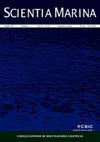Effects of six diets on the growth and survival rates of postlarvae of red abalone (Haliotis rufescens) and its hybrid (H. rufescens ♀ × H. fulgens ♂)
IF 0.9
4区 生物学
Q4 MARINE & FRESHWATER BIOLOGY
引用次数: 0
Abstract
One of the main bottlenecks in abalone aquaculture is maintaining individuals during the weaning stage, when the natural diet changes from diatoms (postlarvae) to macroalgae (juvenile). During this period, abalone pass through profound morphological and physiological changes, which suitable nutrient requirements must sustain. An inadequate diet can result in adverse effects such as late metamorphosis, starvation, slow growth and even death during this phase. Two strategies have been proposed to increase the growth and survival rates of weaning abalone: (i) extending feeding with benthic diatoms and (ii) abalone hybridization via interspecific crosses. To evaluate the efficiency of the two strategies, we assessed the growth and survival rates of postlarvae of pure red abalone (Haliotis rufescens) and a hybrid obtained by crossing red abalone females with green abalone (H. fulgens) males. Both crosses were supplied with six different diets consisting of either one macroalgae mono-diet (Macrocystis pyrifera or Ulva ohnoi) or a mixture with Navicula incerta. Overall, cross-specific diets achieved better growth rates, suggesting that each cross may need specific food items (nutrients) during weaning. Moreover, pure red abalone generally showed the highest growth rates, while the hybrid abalone showed the highest survival rates with most tested diets. Hence, hybrids appear to be better at withstanding stressful conditions, and their use in aquaculture could reduce losses and increase commercial production.6种饲料对红鲍鱼(Haliotis rufescens)及其杂种(Haliotis rufescens♀× hfulgens♂)幼鱼生长和存活率的影响
鲍鱼养殖的主要瓶颈之一是在断奶阶段维持个体,此时自然饲料从硅藻(幼虫后期)转变为大型藻类(幼藻)。在此期间,鲍鱼经历了深刻的形态和生理变化,必须维持适当的营养需求。在这一阶段,不适当的饮食会导致不良影响,如变形晚期、饥饿、生长缓慢甚至死亡。为了提高断奶鲍鱼的生长和存活率,提出了两种策略:(i)扩大底栖硅藻的摄食范围;(ii)通过种间杂交实现鲍鱼杂交。为了评价这两种策略的有效性,我们对纯红鲍鱼(Haliotis rufescens)和红鲍鱼雌性与绿鲍鱼(H. fulgens)雄性杂交获得的幼鱼的生长和存活率进行了评估。两个杂交分别饲喂6种不同的饲粮,分别为单一大藻饲粮(pyrifera Macrocystis或Ulva ohnoi)或混合大藻饲粮。总的来说,杂交饲料获得了更好的生长速度,这表明每个杂交仔猪在断奶期间可能需要特定的食物(营养物质)。此外,在大多数试验饲料中,纯红鲍鱼的生长率最高,而杂交鲍鱼的存活率最高。因此,杂交种似乎更能承受压力条件,在水产养殖中使用它们可以减少损失并增加商业产量。
本文章由计算机程序翻译,如有差异,请以英文原文为准。
求助全文
约1分钟内获得全文
求助全文
来源期刊

Scientia Marina
生物-海洋与淡水生物学
CiteScore
2.10
自引率
0.00%
发文量
21
审稿时长
6-12 weeks
期刊介绍:
Scientia Marina is the successor to Investigación Pesquera, a journal of marine sciences published since 1955 by the Institut de Ciències del Mar de Barcelona (CSIC). Scientia Marina is included in the Science Citation Index since 1998 and publishes original papers, reviews and comments concerning research in the following fields: Marine Biology and Ecology, Fisheries and Fisheries Ecology, Systematics, Faunistics and Marine Biogeography, Physical Oceanography, Chemical Oceanography, and Marine Geology. Emphasis is placed on articles of an interdisciplinary nature and of general interest.
 求助内容:
求助内容: 应助结果提醒方式:
应助结果提醒方式:


